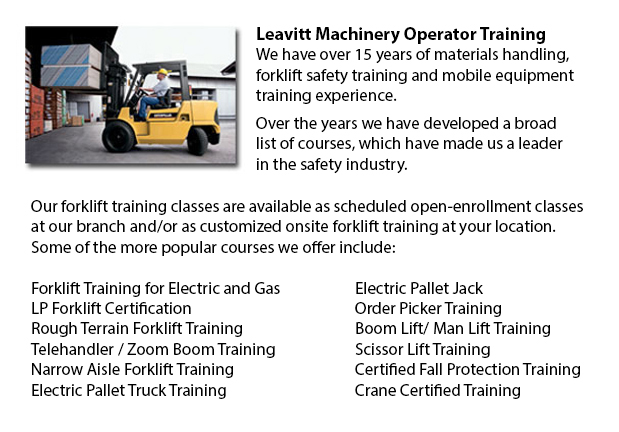
Rough Terrain Forklifts Training Prince Albert - There are actually two classifications of lift trucks within the production business, the rough terrain model and the industrial version. Rough terrain forklifts appeared in the 1940's intended predominantly for use on rough surfaces, best for lumberyards and building sites, providing hauling muscle when there was no paved surface accessible.
Usually, the majority of rough terrain forklifts are run on a propane, diesel or gas powered internal combustion engines with a battery used for power. Some suppliers are experimenting with rough ground forklifts that consume vegetable matter and run from ethanol. Substantial pneumatic tires with deep treads typify these lift trucks to permit them to latch onto the roughest soil type without any slippage or shifting.
A number of of the original designs of rough terrain forklifts had the capability to haul in excess of 1000 lbs, via forks that could run under the item, haul it marginally and shift it to another location. After ten years on the market, all terrain forklifts were enhanced with additional hauling power, increasing the possible cargo to more than 2000 lbs. Telescoping booms were added in the 1960's, permitting them to stack materials much higher than in previous years. The telescoping model feature is a staple of most all terrain forklifts at the moment. Present models are capable of handling well over 4000 lbs thanks to the continued improvements over the years. Telescoping capability has additionally improved with some styles attaining a height of 35 feet. Operator safety has also become a focus with a lot of rough terrain lift trucks now built are fitted with an enclosed cab for the driver, as opposed to the older open air seating capacity.
The all terrain lift trucks existing these days work equally as well on covered floors as on unpaved surfaces. These rough terrain lift trucks are being marketed for their versatility allowing companies to transfer parts from outside the facility to the inside or vice versa.
-
Aerial Lifts
Aerial Lift Training Prince Albert - Aerial lift trucks can accommodate various tasks involving high and tricky reaching spaces. Often used to complete daily preservation in buildings with high ceilings, prune tree branches, elevate burdensome shelvi... More -
Reach Trucks
Reach Truck Training Prince Albert - Reach trucks are loading devices used by varieties of companies that preserve a storage facility or distribution center concerning the organization of completed goods and supplies on pallets which are inserted int... More -
Scissor Lifts
Scissor Lift Training Prince Albert - The scissor lift, often acknowledged as a table lift, is an industrial lift that has been modified for usage within wholesale and retail settings. Industrial lifts have been utilized for decades in the manufactur... More -
Pneumatic Forklifts
Pneumatic Forklifts Training Prince Albert - Pneumatic lift trucks are generally known as pallet trucks or pump trucks and are extensively utilized in warehouses and shipping plants to transfer materials on pallets. Pneumatic lift trucks comprises a... More -
Toyota Forklift
Toyota Forklift Training Prince Albert - Since 1992, Toyota Material Handling inc., U.S.A., also called TMHU, continues to be the best selling lift truck dealer in the United States. Proudly celebrating more than 40 years of performance, the Irvine,... More

Forklift Training Prince Albert
TOLL FREE: 1-888-254-6157
Prince Albert, Saskatchewan
forklifttrainingprincealbert.com
Email Us
About Us


